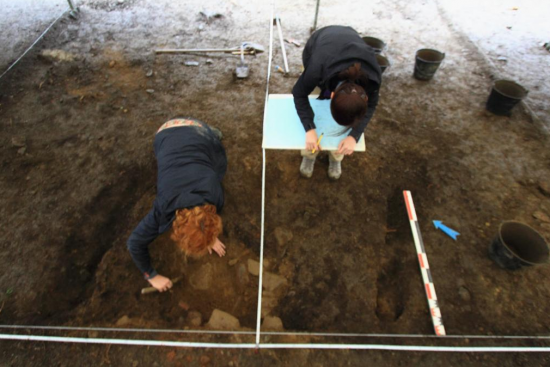PAP - Science and Scholarship in Poland
Source - http://www.naukawpolsce.pap.pl/en/news/news,401502,polish-archaeologists-study-celtic-oppidum-in-france.html

Documentation and measurements on the archaeological site in Bibracte. Photo by T. Bochnak
Polish archaeologists explore the remains of metallurgical workshops in Bibracte, 2 thousand years old Celtic fortified settlement on the border of contemporary departments of Yonne and Saône-et-Loire in Burgundy, France.
"In the oppidum we explore, in the winter 52/51 BC Julius Caesar wrote the famous >>Gallic War<<" - explained Dr. Tomasz Bochnak, an employee of the Institute of Archaeology, University of Rzeszów, who coordinates the work of the Polish team.
The aim of the excavation is to identify the building layout north of the main road in the area adjacent to the main gate of the oppidum. To date, archaeologists were able to identify workshops of bronze-smiths and enamellers. It is a sloping terrain, so the ancients constructed terraces on which they erected buildings. Buildings had several storeys, with entrances located at different levels.
"This year, we discover mainly traces of metallurgical operations, primarily slags, but also coins and fibulas, or pins. After two weeks of work we have also dug up close to 100 kg of fragments of ancient amphorae. This number is likely to increase significantly before the study ends" - said Dr. Bochnak. He added that the Greek historian Diodorus Siculus wrote that an amphora of wine cost as much as the slave who would carry it. On the whole site, since the studies resumed in the 1980s, archaeologists have discovered more than 30 tons of this type of vessels.

Documentation and measurements on the archaeological site in Bibracte. Photo by T. Bochnak
Excavations in Bibracte began already in the nineteenth century and were interrupted by the outbreak of the World War I. Archaeologists returned to the site in the 1980s. Gradually, extensive research centre was established around the hill, used by scientists from around the world. Polish archaeologists joined the team in 2005. Until 2008 they were part of the French-Polish-Czech team, led by Prof. Jean-Paul Guillaumet. Since 2009, Polish archaeologists conduct excavations in partnership with Dr. Petra Goláňová of Masaryk University in Brno. The project also involves a ceramics expert from the Archaeological Museum in Kraków and students from the Institute of Archaeology in Rzeszów, Institute of Prehistory, Adam Mickiewicz University, and the Institute of Archaeology, University of Warsaw.

Imprint on one of the discovered amphorae fragments. Photo by T. Bochnak
The ancient Bibracte was the main city of one of the most powerful Celtic tribes - the Aedui. Oppidum was founded probably in the late third or early second century BC. It was abandoned at the turn of the eras. Its residents owed their strong position to favourable location: between the upper Rhone, the upper Seine and the upper Loire. Goods, especially numerous amphorae with wine, floated down the Rhone from Masalia. Then they were transported to the Seine and the Loire, and floated to the western and northern Gaul. In the middle of the junction was Bibracte. Powerful hill was surrounded by two rings of defensive walls.
"Approximately 100 tons of nails were used to build these walls, and the amount of wood needed for this purpose would grown on the area surrounded by the walls, 200 hectares. The area was larger than the medieval Kraków" - described Dr. Bochnak.
The decline of the oppidum came with the defeat of the coalition of Celtic tribes led by Vercingetorix by the Romans in 52 BC. Luckily for archaeologists, for nearly two millennia since abandonment oppidum, human activity in the area has been small, and discovered relics of buildings from Celtic times and the reign of Octavian Augustus are often well preserved.